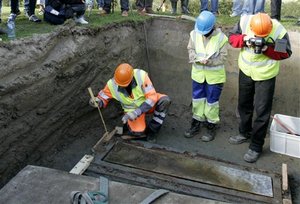
|
| ©AP Photo/ Peder Gjersoe / SCANPIX |
| Norwegian archaeologists exhume the body of a Viking queen. |
OSLO, Norway - Archaeologists opened a Viking burial mound on Monday, seeking to learn more about two women _ possibly a queen and a princess _ laid to rest there 1,173 years ago.
In 1904, the mound in southeastern Norway's Vestfold County surrendered one of the country's greatest archaeological treasures, the Oseberg Viking longboat, which is now on display at the Viking Ship Museum in Oslo.
The 65-foot vessel was buried in 834 in the enormous mound as the grave ship for a rich and powerful Viking woman, according to the museum.
The remains of the two women, one believed to have been in her 60s and the other in her 30s, were first exhumed during the ship excavation. They were reburied in the mound in 1948 _ in a modern aluminum casket placed inside a five-ton stone sarcophagus _ in hopes that future scientific methods might reveal their secrets.
When experts opened the sarcophagus Monday, it was filled with water, although the casket itself may not have been flooded.
"We were surprised when we removed the lid of the sarcophagus that it was filled with water," project leader Vivian Wangen of the Museum of Cultural History told the Norwegian news agency NTB. "We hope the casket and the remains are intact. We won't find out until tomorrow."
The casket was transported back to the Viking Ship Museum and will be opened under controlled conditions on Tuesday. The remains will be kept at the museum for study.
As many as 300 people, including schoolchildren, attended the grave opening.
Wangen said scientists hope the remains are intact enough to give more information about who the women were and how they lived.
An earlier study of a few fragments of the remains that were not reburied, led by Per Holck at the University of Oslo, suggested the older woman was the powerful Viking Queen Aasa, while the younger one could have been her daughter. Another theory is that the second woman was a slave, killed to accompany her master into the afterlife.
Later in the week, the archaeologists plan to reopen a second burial site, called the Gokstad Mound, on the opposite side of the Oslo fjord. Viking-era bone fragments were reburied there in 1928, nearly 50 years after the grave was opened to excavate another Viking Ship in 1880. That 79-foot ship, believed buried about 900, is also on display at the Viking Ship Museum in Oslo.



Reader Comments
to our Newsletter